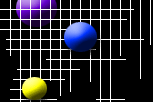|
The Early Years.
The image to the right is the earliest known remaining image of CTDYNE custom tag gear, built approximately 1991. This
was the fourth custom ever produced. Unfortunately, this unit along with the three previous models were disassembled
so that the parts could be used for follow-on models.
This tagger was originally built using a Lazer Pro 9000, which can be seen on top at the forward end. After the
first Laser Challenge gear was introduced this tagger received a modification to accept a second set of electronics and a
second optic barrel assembly. It can be seen on the right side (yellow). The adjustable focus spot light on this
unit was quite bright. The heat put out by the high intensity bulb required the manufacture of a custom aluminum receiver
to accept the bulb. Even so, the light could only be used intermittantly, as the heat would start to melt the plastic housing
after 20 to 30 seconds!
Matt's Menacer
Created in the 1991/1992 time frame, this unit started as a Lazer PRO 9000 custom (visible on the forward right). After
the release of the first Laser Challenge gear it was modified to accept an LC electronics set and a second optic barrel
assembly (on the forward left).
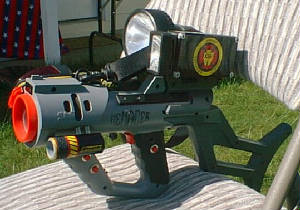
A nice feature of this unit is how adaptable it is. There is a AA battery pack in the main housing to power just
the two tagger electric sets along with the red tunnel light. This allows the upper assembly containing the 1800 mAh
battery pack, strobe light and spot light to be removed along with the stock to provide a light weight small tagger. This
can be done without tools in under a minute. The procedure can just as easily be reversed for a full-sized tagger optimized
for night time use.
Mike's LC PRO
This unit was the first Laser Challenge PRO based custom built at CTDYNE sometime around 1996. In anticipation
of the release of the Firestorm, an add-on module was fabricated so the firestorm could be easily added to an accessory rail
on the bottom of the foregrip.
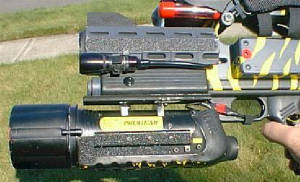
The design for this custom called for an array of accessories that could be added or removed as needed for the type
of game and the time of day it was being used. Some of these accessories included a camcorder, night vision scope, two different
spotlights and the Firestorm module.
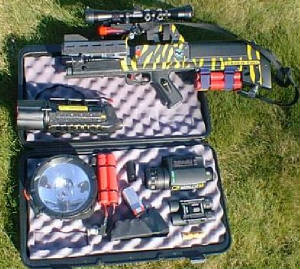
There are four different IR LED's. Two have no lens and are 60 and 20 degree spread. A one-inch lens is used for
medium range targets and a two-inch lens is for longer shots. All of these emitters are selected by a thumb wheel selector
and are fired by the main trigger.
The original LC PRO keypad was unreliable and was replaced by a set of four higher quality momentary contacts for more
consistent input to the CPU of the LC PRO board. The three original sensors from the PRO are mounted in the housing.
The forward facing sensor is in front of the ramp sight, along with the right side target. The left side target is located
about halfway down the tagger.
Powered by dual 7.2 volt rechargeable battery packs, each with it's own meter to monitor charge levels. The
14.4 volts is routed to a voltage/current regulator board and is then sent to the various components. There is a small cooling
fan mounted on the regulator board. This can be activated as needed to keep the board within operating limits. The projection
beam spotlight can be swapped for a five inch 100,000 candle power spotlight in less than two minutes. Both of these lights
run directly off of 14.4 volt power with no current or voltage regulation.
Matt's LC PRO
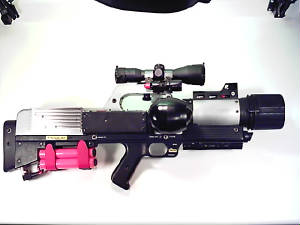
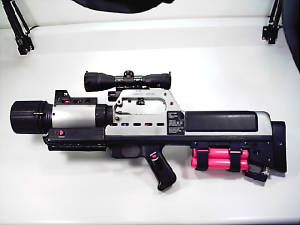
This tagger has the three sensors from the PRO built into it. The front sensor is facing forward on the ramp sight
along with the right hand sensor facing to the right. The left sensor is located at about the middle of the tagger.
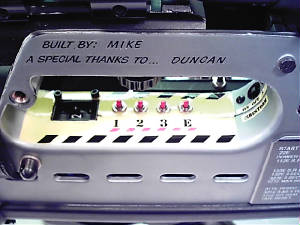
This LC PRO custom also features selectable recoil/hit vibration and silencer button.
Kelly's Ultrawide and V2 Tagger
This pair of V2 customs has seen years of hard use. The Ultrawide has been modified with a silencer button, flashlight,
sling and camo paint.

Mike's L.A.C.S.R.
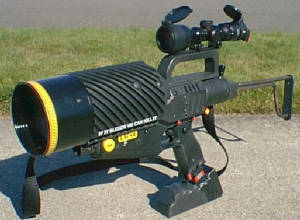

Other features include: silencer, 3X9 variable scope, sling and side fold stock. The package is very well balanced and
is easy to use for extended periods of time considering the lens size and weight. The sling is quite handy for extended
use as well. The 12 cell battery pack will last an entire weekend of tagging without recharging.

The image to the right shows the aft end of the four inch LED bulkhead. The wiring for each of the six IR LEDs that
make up the array is visible. If you look closely, the back side of each LED can be seen in the mounting holes. Each
of the six IR LEDs is wired to its own power resistor on the booster board, so each LED is driven at one full amp. We "let
the smoke out" of the LEDs a few times until Duncan figured out the proper formula.
Pinky and the Brain
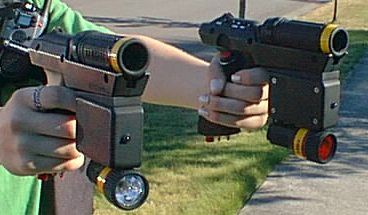
Each features a one inch lens and a second IR LED with no lens. Matt can select between the one inch lens and the
20 degree LED by means of a selector switch. Both LED's are fired by the main trigger. The one inch lens provides decent range
for a small tagger and the non lens LED has a great spread for close quarters work in and around the tunnels at the forts.
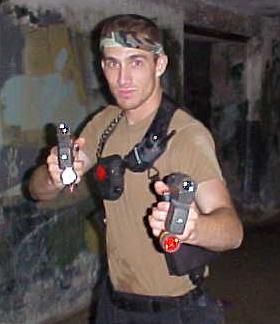
Both of these taggers have a light attached. Pinky has a red light used at night or in the tunnels when Matt does
not want to give his position away. The Brain has a bright white light for use when Matt needs to illuminate his target.
Small Custom Taggers
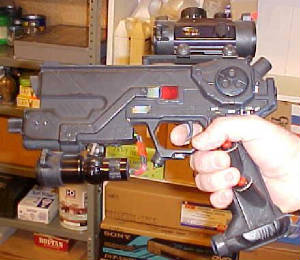
The unit with the red dot sight and the tactical light mounted under the barrel has a seven cell sub "C"
1800 mHA rechargable battery pack built into the tagger. It is recharged by removing the cap on the end of the grip and
plugging in the charger. With this much capacity you can use this tagger for an entire weekend without recharging.
|
